Q&A – Ask Neil: July 27, 2023
(Please read these instructions carefully.)
Before you post your question, please look at recent issues to see if someone else has already asked it. You might find your answer there.
How to submit your question…
(Note: You may need to allow a pop-up window to come up in order to get the link for sending your photo(s). If you have already submitted your question and didn’t see the pop-up window, please click here.)
• Click the link provided below to post your question. After you submit your question, a new window will pop up giving you the address to which you can e-mail a SHARP, HIGH-RESOLUTION PHOTO to accompany your question. Please DO NOT SEND THUMBNAIL PHOTOS in case I need to zoom in to see things.
• Click here to post your question.
• Please ONLY POST YOUR QUESTION ONE TIME. We can only accept a set number of questions each week, and when we get duplicates it costs other people their chances.
• One question per reader, please.
• Please use this only for posting questions – not for standard emails.
• Watch for your answer in the following week’s e-gardens.
• I choose those of greatest general interest. For example, plant IDs seldom make the cut.
• I must have your first name or initials.
• I must have your city or county. (Texas is a very large state.)
QUESTION 1
SHOULD JAPANESE MAPLE BE REPLANTED LOWER? SHOULD THE ONE ROOT BE REMOVED?
Question: This 10-gallon Bloodgood Japanese maple was planted this past March. Is the crown too high? Should it be replanted? If so, when? Also, something has chewed on one root. That root appears to be girdling the trunk. Should that root be removed? Jeff S., The Colony.

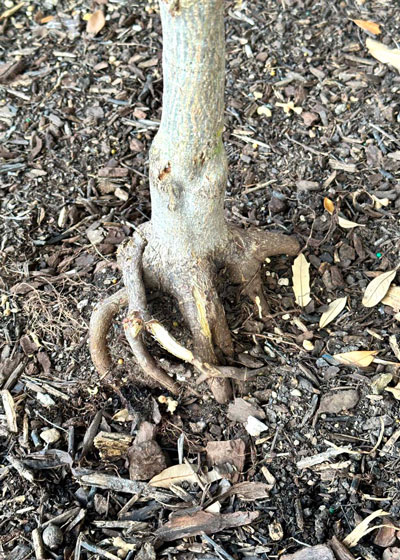
Answer: Those roots do need to be covered. If the tree has sunk down into its planting hole, you might get by with simply adding soil around the trunk. In looking at your photo carefully, it does appear that you could add an inch of topsoil without harming the tree, then another inch of bark mulch. Otherwise, yes, you should dig and reset it this winter. It would be much better for the tree if just adding soil would solve the issue, though. As for the roots, it looks like it’s been scraped more than like some animal has been chewing. Trim away the one root that is turning back over the largest root and just watch what happens with it for a few months.
QUESTION 2
IS IT UNUSUAL FOR BAGWORMS TO ATTACK RED OAKS?
Question: I thought it was unusual for bagworms to attack red oaks. What do you think? Lance Q., Ponder, Denton County.

Answer: It is unusual, but certainly not unheard of. In fact, there are types of bagworms that actually prefer specific deciduous species. This information from Texas A&M will give more details.
It’s unlikely that they would do any serious long-term damage to an oak because oaks and most other broadleafed trees have dormant buds that are able to sprout out as new shoots. Junipers and other conifers lack those buds. Still, if you’re concerned, you could spray with B.t. or almost any general-purpose insecticide while they are feeding actively. Once they stop feeding and tie the bags shut, about all you can do is pick them off by hand.
In the off chance that you might like to see what TAMU had to say about bagworms almost 100 years ago, in researching my answer for you, I came across this historic bulletin from 1928 from the A&M archives.
The Bagworms of Texas by F.M. Jones and H.B. Parks, Bulletin 382 from Texas A&M from 1928! https://oaktrust.library.tamu.edu/handle/1969.1/4111
QUESTION 3
WHAT HAS HAPPENED TO MY PEAR TREE? IT IS GOING DOWNHILL RAPIDLY.
Question: What has happened to my Moonglow pear tree? It looks worse each day and watering does not help. Frank G., Sanger, Denton County.
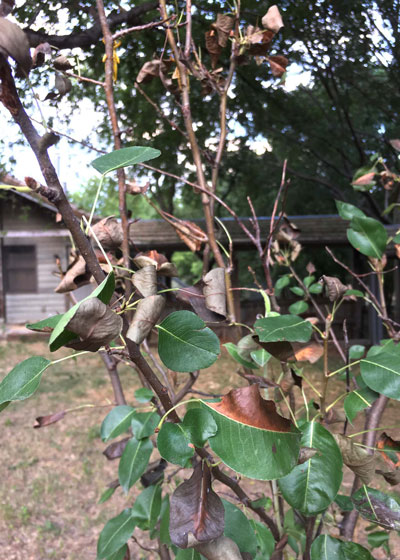
Answer: This is fire blight, the scourge of quality pear varieties all over the world. It’s a bacterial infection that bees carry into the flowers in the spring. It suddenly kills the shoots 6 to 20 inches back from their tips making them look like they’d been hit with a blowtorch. Moonglow is listed as being somewhat resistant to fire blight, but obviously the infection is having its way with your tree and it may not be possible to save it.
There is an interesting correlation between the number of grit cells in pear fruit and that variety’s ability to fend off fire blight. Grit cells make the fruit hard, so obviously, the higher quality varieties like Bartlett have fewer grit cells compared to the old Texas standard Kieffer pears. Moonglow is a compromise.
This fact sheet, “Pears” (EHT-023) by three of Texas A&M’s most respected fruit experts, gives great information on variety selection and care, plus fire blight and how to deal with it.
Your only recourse now is to prune out the diseased growth. Cut 8 to 10 inches beyond the infected area in each case, then disinfect your pruning tool in a 10 percent chlorine bleach solution before moving on to any other pruning. Dry and oil the cutting tool when you are finished to prevent rusting.
You will see recommendations for spraying next spring while your pear is in bloom if you decide the tree is worth all the effort. Good luck. It’s a shame all this happened.
QUESTION 4
HOW WELL WILL ARBUTUS TREES DO IN TEXAS LANDSCAPES?
Question: What is your opinion of Arbutus trees for landscaping in Texas? H.J. Mc., Denton.
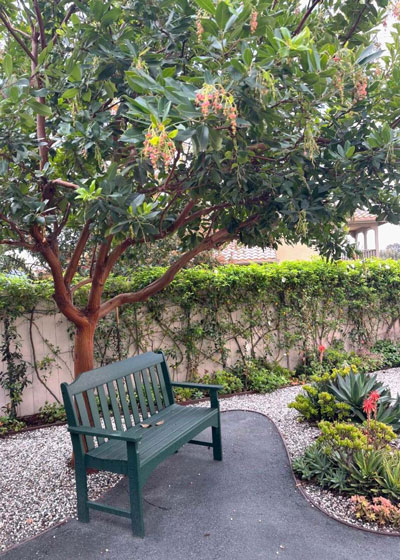
Answer: In Texas? It’s a big state. I assume you’re asking about Arbutus xalapensis, the Texas madrone. In Southwest Texas it would be great for any patient gardener who would be willing to wait for it to grow and develop its beautiful trunks and branches. As I spent summers working alongside my dad as he did his poison-plant research in the Texas Hill Country and Southwest Texas in general, I saw hundreds of these that would have been stunning in landscapes. But they’re almost impossible to transplant and abundantly slow to grow in a nursery setting. My friend Benny Simpson at the Texas A&M Research Center in Dallas grew a few dozen and gave me one for my personal enjoyment. I left mine in a pot for many years. I believe Benny may have lost his in an extremely cold winter spell in the late 1970s. Denton is colder still than where Benny had his on Coit Road in North Dallas if you’re asking with your county in mind. It’s a beautiful plant, but it would not have survived the past two winters in Denton I don’t believe. Proceed cautiously.
QUESTION 5
GOOD OR BAD IDEA? TWO SMALL JAPANESE MAPLES PLANTED WITHIN BED OF INLAND SEA OATS. GRASSHOPPERS HAVE EATEN EVERYTHING.
Question: I planted two small 3-gallon Japanese maples in October 2022 into an area of inland sea oats. Grasshoppers have consumed almost all of the leaves now. I covered them with cheesecloth in the hopes of preventing more grasshopper damage. Was this a good idea or a bad one? Michael C., Denton.
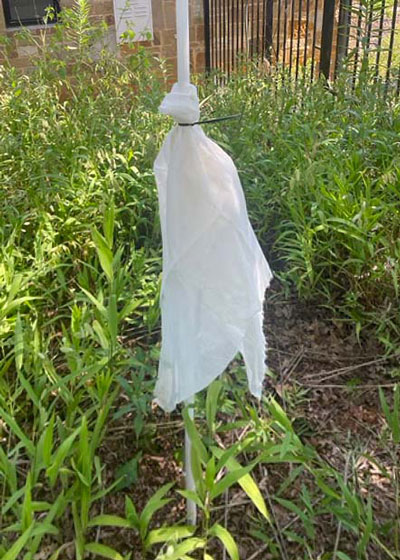
Answer: Probably not a good idea. In fact, inland sea oats in general are probably not a good idea in any landscape. I learned the hard way. They have to be the most invasive ornamental grass in Texas. And, grasshoppers earned their name by feeding on grasses. When two baby Japanese maples show up for the feast, they’re just going to be appetizers. I believe I would either move the maples or remove and replace the grass. (It’s taken 5 years, but I think I have finally gotten all of it out of my landscape.)
QUESTION 6
WHAT IS WRONG WITH THE ONE PECAN TREE? THE MAIN CENTER BRANCH HAS DIED AND THE TREE HAS YELLOWED.
Question: I am concerned about one of my pecan trees. The other pecans are nice and green, but one has turned yellow. I’ve tried to give them the same amount of water. The center branch has also died. Is this some kind of borer? Byron L., Forney.
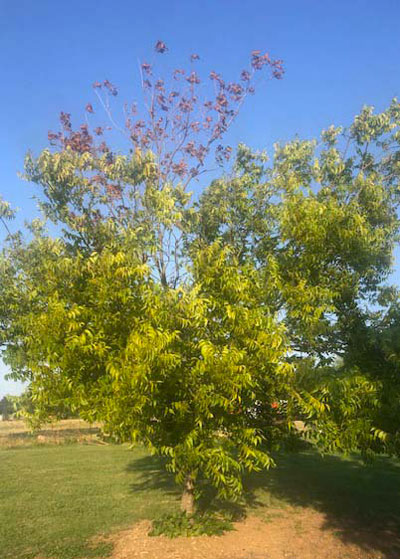

Answer: I can’t tell, but you’re on the right track by looking inside the canopy at that one branch (trunk) to see what is different there. I’ve never seen borers do that kind of damage on any of our 11 acres of pecans, but decay from a branch breaking off certainly will. Even a small twig that doesn’t heal properly will lead to this kind of dieback. The yellowing is likely due to insufficient nitrogen. It may be that it just needs to be fed better next spring, or it may be that the trunk issue is interfering with the tree’s ability to carry nitrogen from the roots up to the leaves. I do not believe it is related to the amount of water you’ve given it, as your part of the Metroplex has had adequate rain to date. Do some more critical searching along that one dying branch. I suspect you’ll find the answer there. It also looks like the rest of the tree needs a bit of pruning to establish its primary side branches and to remove any unwanted limbs. Some of that bottom growth needs to go away. If you prefer to wait for winter when you can see through the tree and better analyze your options, that would be fine.
QUESTION 7
WHAT DOES A MIDNIGHT MARVEL HARDY HIBISCUS SEED LOOK LIKE?
Question: Please show me what the seed for Midnight Marvel hardy hibiscus looks like. We have tried to gather some, but they aren’t the same as typical hibiscus seeds. Are they different? Varsi K., Keller.
Answer: This is a stunning introduction from the folks at Walters Gardens in Michigan. Here is its spot on their website. Being a hybrid, it’s almost assuredly propagated asexually (tissue culture, small cuttings, etc.) to be sure the genetics stay the same. Obviously, it could be divided, but since it’s still under patent, that can’t be done with the intent to sell.
Having all that verbiage out of the way, I would expect its seeds to look pretty much like the seeds from any other mallow. They’ll be approximately BB-sized and there should be 30-40 in each capsule.
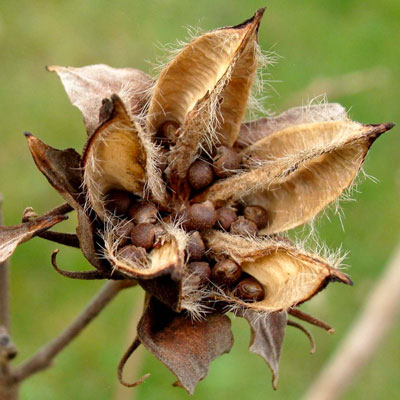
I searched online for photos of hardy hibiscus (mallow) seeds. This one popped up, but I couldn’t find anyone to whom I could give credit.
Not having grown this selection personally (I have primarily shade) I’m not going to guarantee much of what I just wrote. I did a good bit of looking on your behalf and I don’t see any reason that you shouldn’t be able to find seeds.
QUESTION 8
WHY IS OUR CRAPE MYRTLE DYING BACK?
Question: I’ve attached photos of the crape myrtle we spoke about on the radio. As you can see, there are dead branches appearing randomly, somewhat on the north side but mostly on the west. It has lost its first round of blooms, but it is still shedding bark. I’ve tried to trace the dieback down the trunk, but it’s difficult. Can you tell the variety from the photos? You said that might give a clue as to the dieback. Sandy H., Coppell.
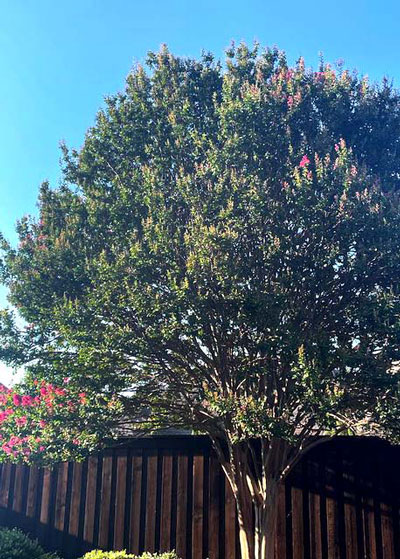
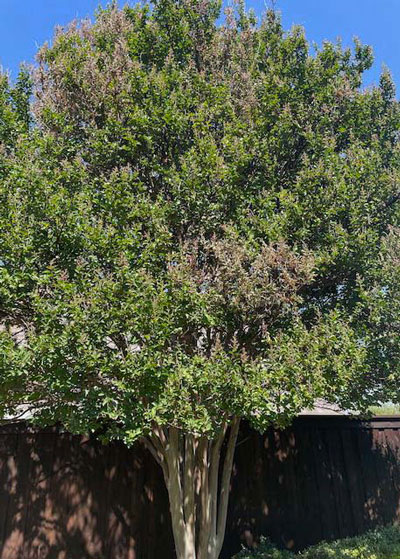

Answer: Thanks for the photos. They’re very helpful. The tree looks vigorous other than the couple of trunks that have suffered what I think is freeze damage. This looks like Tuscarora, although I can’t tell for sure. It grows quickly, so it’s a favorite with wholesale nurseries. We have scores of them in our Crape Myrtle Trails of McKinney. Our city is probably 6 or 8 degrees colder most winter nights than you are in Coppell, plus the fence would offer a good deal of protection from the cold winds. Our Tuscaroras took a beating in February 2021 and again around Christmas in 2022. Many of them have only half their normal top growth and, in some cases in private landscapes, really need to be pruned to the ground and retrained from the shoots coming up from the ground.
Bark peeling off, as you’re probably aware, is a normal occurrence for crape myrtles, so that’s of no concern. And I see so much new growth at the ends of the healthy branches, that I’m confident that your plant will be fine in the long run. Your plan going forward probably should be to use a thin saw to cut and remove all the dead trunks. Cut them flush with remaining trunks or branches so you don’t leave stubs around which new shoots will sprout. Apply an all-nitrogen lawn fertilizer around the plant in late March next spring to promote vigorous growth out of the blocks. Hopefully we won’t have a repeat of the record cold winter weather.
QUESTION 9
WHY WOULD MY GAURA PLANTS’ FLOWER BUDS NOT OPEN?
Question: Here are photos of my gaura plants and their flower buds that are not opening as we discussed on the radio last Sunday. Thanks for the chance to send you photos for your inspection. For what it’s worth, penstemons right next to the gauras are not opening either. Gail W., Waco.
Answer: I have spent most of an hour trying to figure the correct answer for you. I searched online, but there just isn’t much information out there. Thrips are the usual suspects when flower buds don’t open properly, but they aren’t mentioned in most of the information on gauras that I found. Spider mites get mentioned, so I guess thumping a couple of the flower stalks might be a good test to see if any pests fall out and start walking around. They will be ultra-tiny, so thump over a clean sheet of white paper and in a bright window.
Your photos were outstanding. I sent them on to a couple of friends who plant a lot of color and they were as stumped as I am. One suggested that perhaps the plants got too dry one time, or maybe they were hit with a glancing blow of a weedkiller. Having spoken with you I know you’re a good gardener, so those may not be very strong possibilities. I’ll keep looking and listening. If someone else has suggestions or if I come up with something new, I’ll reach back to you through your contact info you sent us. I’m sorry I don’t have anything more definitive.
